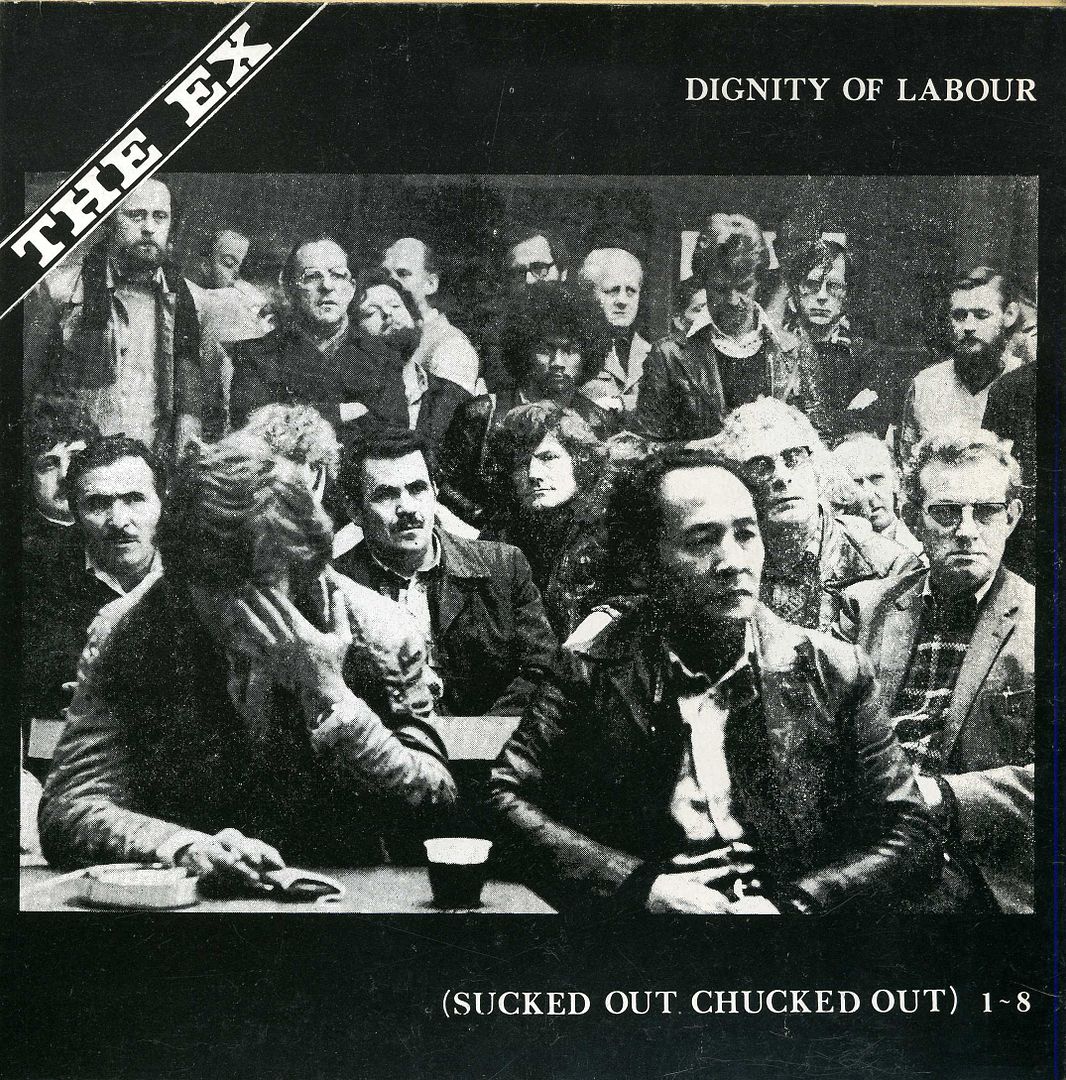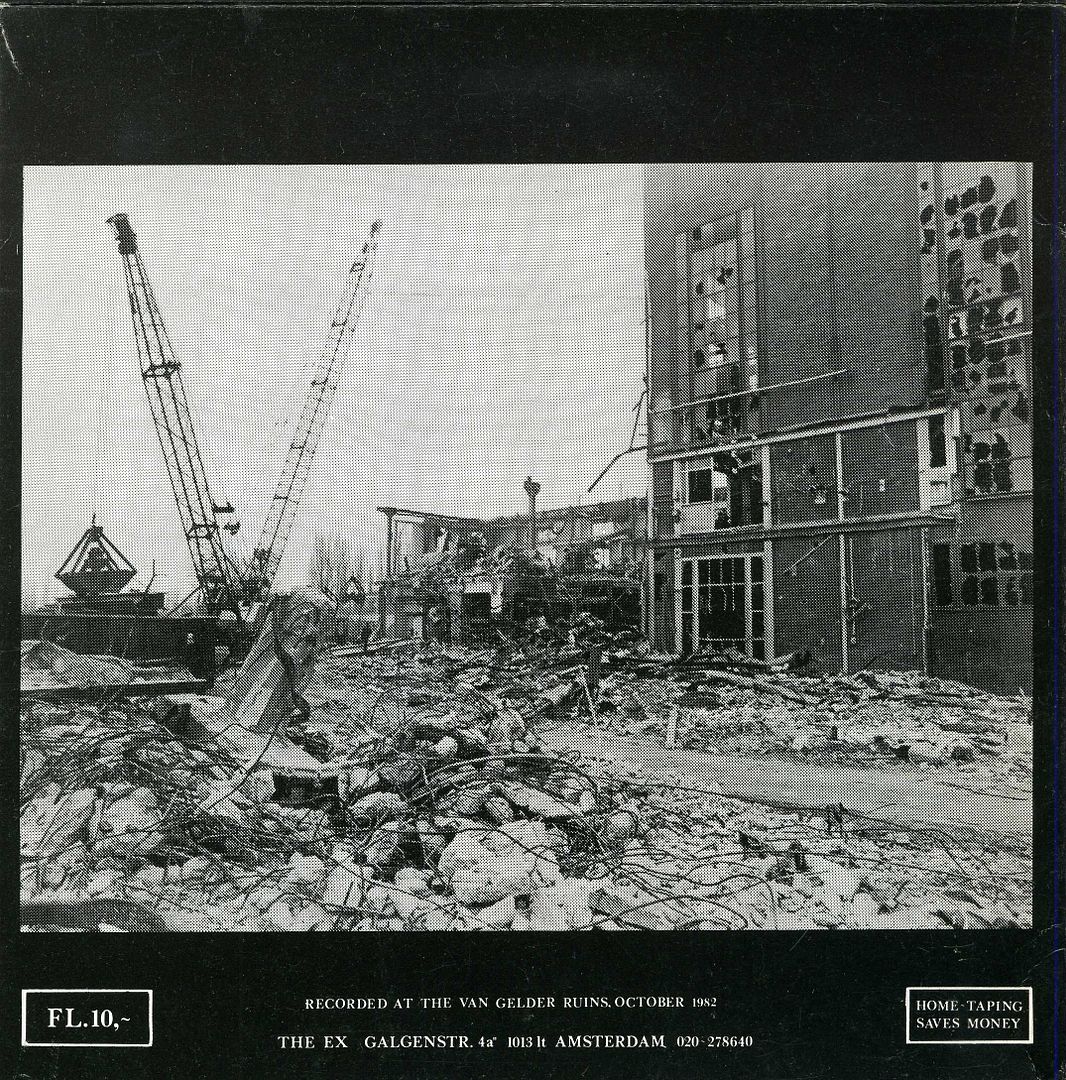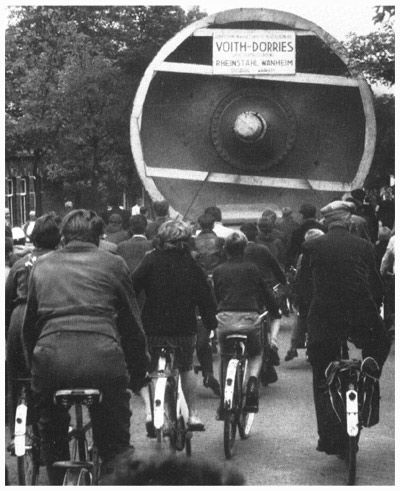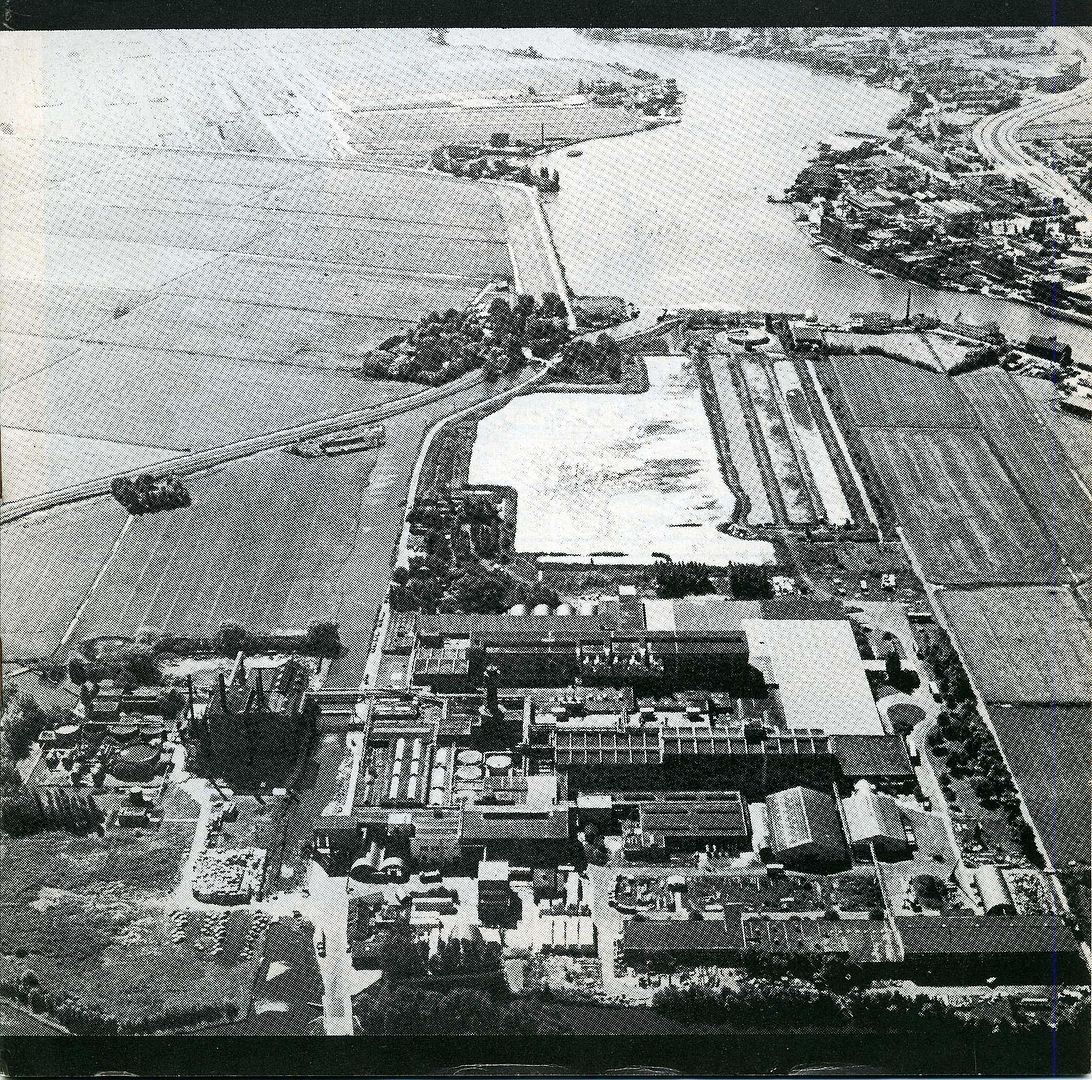


A conceptual project by The Ex concerning the shutting down of the Van Gelder paper and asbestos felt factory in Wormer in 1981 with the loss of 550 jobs. A bullet point dated history for this factory is written out below for anyone that cares to shift through any of the facts.
The Ex’s sound is much more industrial on this release, hardly surprising given the subject matter. I also believe that some members were squatting in the ruins of this old factory. The band recorded some of the tracks within this old industrial site so it is not too unlikely that some of the band may have lived there for a while.
The recorded tracks for this project form eight sides of 7″ vinyl. All four 7″ records are nicely housed in a thin cardboard box with a large poster / lyric sheet, and a booklet explaining the closure and the illnesses which occured in some of the workforce from the mishandling of asbestos felt.

|
Prehistory (1685 – 1784) created by industrial activity |
|
| 1685 | Wormer gets the oil mill to wind law (Simon Pzn. Fent) |
| 1728 | Sales for 1350 fl, – to Jan Pzn. Coopman, conversion to exchange paperwork had numerous owners, including several times in the hands of members of the family Honigh. |
| 1775 | Maarten Schouten Wormerveer to buy the mill for fl 3150, — |
| 1783 | Schmidt Pieter van Gelder, son of a preacher, married the daughter of Martin Schouten |
| 1784 | Pieter and is his father-in law Eendragt listed as co-partners |
|
From hand to create paper (1784 – 1864) |
|
| 1803 | Purchase of packing paper mill Bok |
| 1817 | Purchase the paper mill Kruiskerk |
| 1820 | Purchase of packing paper mill Soldier |
| 1837 | Purchase paper mill Fortune |
| 1838 | First paper made in Fortune, devoured many years the profit |
| 1839 | Sales breakdown for the Soldier |
| 1840 | Omhouw of the white-to brown paper Eendragt |
| 1841 | The Kreuzkirche activity (sold in 1843) |
| 1845 | The Eendracht is wrapping machine works under the name Van Gelder Zonen |
| 1855 | Sales at Fortune Honig |
| 1858 | Commercial Paper to Amsterdam (OZ Voorburgwal) |
| 1863 | Scrapping the Bok, the production Eendragt |
|
Expansion (1864 – 1914) |
|
| 1869 | Purchase the paper Eendracht in Apeldoorn manufacturing white paper, handmade |
| 1876 | New paper mill in Wormer |
| 1881 | Imported wood pulp and cellulose |
| 1887 | Paper Trading to OZVoorburgwal Singel Amsterdam |
| 1888 | Second paper in Wormer |
| 1889 | Eendragt demolished the old mill and a flour mill rebuilt Emst |
| 1890 | Wormer makes white printing paper for newspapers |
| 1892 | Wormer rotation is current pressure for the News of the Day |
| 1895 | Current construction paper in Velsen |
| 1899 | First paper mill in Apeldoorn |
| 1900 | SA created (office Velsen), fl capital 2,500,000 — |
| 1901 | Construction plant cellulose Velsen |
| 1904 | Drafting paper scoop in Apeldoorn |
| 1905 | Scriptures in Apeldoorn |
| 1907 | Purchase paper Renkum (Renkum I) |
| 1908 | Construction dust timber plant in Velsen |
| 1911 | Construction sulphite cellulose factory Velsen |
| 1912 | Construction paper in half courant Renkum (Renkum II, the Rhine) |
| 1912 | Establishment Timber Hollandse Maatschappij NV |
| 1913 | NV office moved from Velsen to Amsterdam (Singel) |
|
Between two world wars (1914 – 1945) |
|
| 1915 | London office founded his own steamship De Eendracht |
| 1917 | Holland Timber removed |
| 1918 | London office and own ship for disposal |
| 1920 — 1924 |
Weakness, abundant supplies, German competition |
| 1924 – 1929 | Stabilization, develop markets, new paper machines in Wormer, and I Renkum Apeldoorn (Wormer 1928, 4 PM) |
| 1929 — 1939 |
Heavy crisis, competition in Scandinavia, restrict production, unemployment, until around 1937 some recovery; new current paper Velsen |
| 1940 — 1944 |
Production is declining and finally put everything stop, Renkum I and II heavily damaged by war, German soldiers plundered Wormer, Velsen under threat of destruction, partly plundered |
|
Recovery (1944 – 1949) |
|
| 1945 | In September Apeldoorn, Velsen, Wormer again no timber production, working with straw, wood pulp and cellulose |
| 1946 | Renkum end of the year in business, imported wood begins to run anything |
| 1947 | Little wood available, use of straw stopped |
| 1948 | Gains in commodity supply |
|
Period 1949 – 1979 |
|
| 1949 | Paper 13 in Apeldoorn |
| 1950 | 9 paper machine in Apeldoorn |
| 1952 | Paper 11 in Wormer (Yankee paper machine) |
| 1954 | Timber planting plans in Suriname |
| 1956 | Paper 21 in Velsen; agreement with Suriname, test plantings |
| 1957 | Paper 24 in Renkum 22 paper machine in Wormer, acquisition CIB Brussels, Belgium |
| 1958 | Coater in Renkum (III); pulp mills Velsen removed and scrapped |
| 1959 | Processing Arnhem, transferred from Renkum |
| 1960 | Acquisition Gebr. de Jong, Westzaan, zakkenfabrikage |
| 1962 | Acquisition EZC, Westzaan (cardboard); acquisition Berghuizer Papierfabriek to Wapenveld and its related companies in Rotterdam (CatsNeparofa) and Rhoon, milk processing plant for packaging in Veenendaal (75%); houtlosinstallatie in Velsen, pilot stopped in Suriname |
| 1963 | 6 PM in Apeldoorn, in Wapenveld PM 38, PM 51 in Velsen-Zuid, 50% Crown Zeller bach, Friborg sales (50% CZ) |
| 1965 | Research paper mills (Stadler Hurtter) |
| 1967 | Distribution South-Amstel, glass skins production machine 103 in Apeldoorn, production stopped Mopavi (trade only); first paper mills Restructuring Report |
| 1968 | Acquisition Leeuwarder Papierwarenfabriek Franeker and Leeuwarden. Headquarters for Parnassusweg Singel (Amsterdam Zuid). Asbestos Felt Production on paper 10 in Wormer |
| 1969 | Establishment Flevo Wood (25%), Plastic Film Industry Apeldoorn (50% CZ), glass fiber nonwoven machinery production plant in Apeldoorn 104; stopped Gebr. de Zaan Westzaan de Zaan Westzaan |
| 1970 – 1971 |
Failed merger talks Royal Dutch Papierfabriek – KNP Maastricht |
| 1971 | Concentration tape Intergun Naarden (33%), Crown Zeller Bach owns 50% of CVG Van Gelder, Velsen and Friborg, Apeldoorn, Van Gelder FPI be 100%, construction paper 52 in Velsen |
| 1972 | Coating Machine 4 in Arnhem, Handelmij branches. Repealed; EZC Westzaan sold divisional structure |
| 1973 | Intergun Naarden from 33% to 50% |
| 1974 | Establishment Van Gelder Recycling Velsen (40%), establishing Van Gelder GmBH Düsseldorf (sales) |
| 1975 | Acquisition Epacar wholesale Brussels, transfer to Arnhem Apeldoorn |
| 1976 | Creation Tape Systems Apeldoorn (51%), current construction decision paper Renkum III (80%) |
| 1977 | McKinsey research, restructuring Apeldoorn paper, Wapenveld, Wormer, Rotterdam, OVA |
| 1978 | Witpapieronderzoek; research cardboard and flexible packaging; privatization Trade Division; Wormer produce 40,673 tonnes of paper, 28,444 tons of asbestos flooring felt |
| 1979 | Wormer, 4 PM – 4 m wide production of asbestos paper |
| 1980 | McKinsey study on business opportunities for 4 m wide asbestos felt, SFPD – factory Wormer May 13, 1980 decision of the Board of Directors for paper production Wormer stop per liter in July 1980, production on an asbestos felt machine – 2-m wide with 84 workers will continue provisionally |
| 1981 | July 9, 1981 communication from the Board of Directors: Van Gelder Papier no support from the government. “We see us through this practice forced on Friday, July 10 held a request to grant suspension of payments to be submitted to the District Court of Amsterdam |


Niels
December 5, 2009 at 2:09 pmI don’t think (members of) the Ex have ever squatted the actual Van Gelder factory ruins; they did squat one of the houses the factory bosses used to live in: the famous “Witte Villa”, which was later legalized and (as far as I know) is still inhabited by one or two Ex-members!
NXP
December 5, 2009 at 7:11 pmMany thanx for this one. One off the better Ex releases…I think.
shammyleather
December 6, 2009 at 7:54 pmWhat was that Ex album that had a photograph of nazi officers on the front called?
Penguin • Post Author •
December 6, 2009 at 8:08 pm‘History Is What’s Happening’ has nazi officers playing violins on the cover, or possibly dutch locals playing violins with nazi officers watching. Bit hard to tell from the LP sleeve. This was the second LP released by the band.
shammyleather
December 7, 2009 at 6:21 pmCheers Penguin, I had that album and also the first one, I remember listening to the first one with a Belgium guy who was visting the “Poison’s” when I was there at their Leytonstone house and we all said at the same time “that sounds just like Steve Ignorant” when listening to one track. I also recall writing to them and they sent me a really long letter and loads of bumph including a single “Weapons for El Salvador”. Another band I quite liked was “The Rondos” who were like a Dutch take on Crass even with the look and the snare drumming sound but without the original sound Crass had and the really good lyrics.
Penguin • Post Author •
December 7, 2009 at 8:41 pmHere you go shammy:
https://www.killyourpetpuppy.co.uk/news/?p=603
https://www.killyourpetpuppy.co.uk/news/?p=617
DF
December 8, 2009 at 4:34 amThe whole Rondos thing confuses me. Were they ripping off Crass or doing something similar at the same time. On the “Red Attack” LP it doesn’t seem like a coincidence (lyrics typed in/the/same/form// like Crass’, similar graphic design.) but their lyrics are nowhere near similar on the pacifist slant.
Also in that “Story of Crass” book it seems Crass didn’t take kindly to the Rondos, Rimbaud slagging them as Maoist in the bit about Conway Hall. Or were they actual Maoists? I guess I just assume no one is a Maoist; especially since some Rondos were in Ex for a little while, maybe they defected to the anarcho cause.
back2front
December 10, 2009 at 7:24 pmGreat release from a great band! They are on tour with a four piece brass section in the new year and if you haven’t seen them before…..
chris
December 17, 2009 at 9:00 pmThis is quite funny actually as I loved the Rondos from the first time I heard that Red Attack album (at the time it was about THE only other record you could say was similar to Crass).
Having picked up their CD box-set with it’s accompanying book recently I found the ‘truth’ to be most illuminating. Let’s just say ol’ Penny was being a tad disgenuous in the Story of Crass book. Transpires rather than being the thuggish armed robbers (or more inscrutably – ‘Red Brigade’) he painted them as they were in fact all ex-art students, involved with the fluxus art movement and similarily living in a commune/art space (like a Dutch equivalent of Dial House, only in the heart of an industrial city) Likewise, the banners they were photographed playing in front of, which led to the accusations of Maoism being from a well documented show at their art college where the foyer + dining hall were draped in ‘symbols of totalitarianism’. They wholeheartedly admit to being very influenced by Crass, but equally disillusioned with them following Crass’s attitude post Conway Hall gig. Lovely guy tho Penny is, knowing his tendency for historical revisionism I have no doubt as to whose story I would believe. What I find interesting is I suspect part of Crass’ desire to demonise & distort the reality of The Rondos was that they exposed many of the intrinsic failings and contradictions in Crass’ ideology.
AL Puppy
January 22, 2010 at 5:22 pmInterview by Iain Aitch with the Ex in Guardian 22 January
http://www.guardian.co.uk/music/2010/jan/21/the-ex-interview